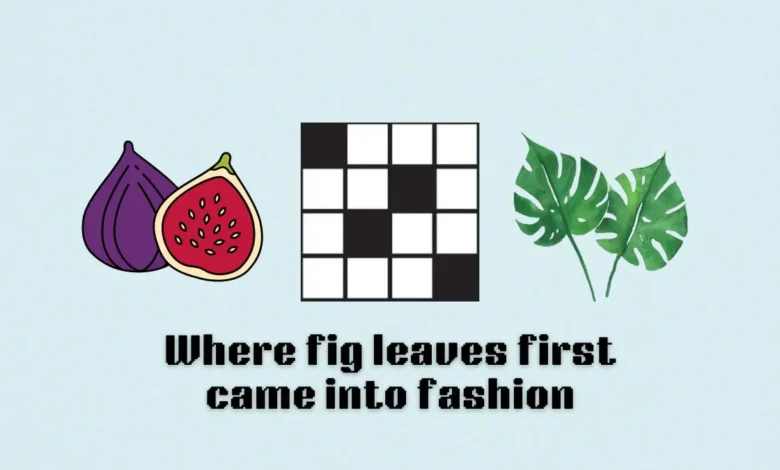Where Fig Leaves First Came Into Fashion

The tale of where fig leaves first came into fashion is more than just a whimsical curiosity; it’s a symbolic journey that reflects the evolution of human modesty, cultural expression, and the playful collision between practicality and myth. This leafy fashion statement, wrapped in biblical lore and artistic tradition, carries a surprisingly deep cultural resonance. From ancient tales to modern interpretations, understanding where fig leaves first came into fashion gives us a new lens to explore how we’ve dressed ourselves not just in cloth, but in symbolism.
It’s easy to dismiss the fig leaf as a quirky artefact of modesty, but in truth, the leaf has covered more than bodies — it’s shielded identities, inspired artists, and sparked commentary on morality. So, where fig leaves first came into fashion is not simply about literal coverage; it’s about cultural covering. Digging into the roots of this botanical wardrobe choice uncovers fascinating stories of ancient civilisation, art censorship, and cheeky satire that have dressed human history in a very particular way.
From Garden Symbolism to Public Display
When we consider where fig leaves first came into fashion, the story almost always begins in the mythic Garden. The first wearers of fig leaves, according to the tale, were not fashion-forward influencers, but rather two individuals reacting to a sudden awareness of vulnerability. The fig leaf became the world’s first emergency outfit, hand-picked not for its cut or comfort but for what it symbolized — the dawning of modesty.
This early moment is less about style and more about the survival of dignity. The question of where fig leaves first came into fashion finds its roots in a world where the leaf served as the original reaction to exposure. The fig leaf didn’t aim to be haute couture; it was a shield against shame. Yet, over time, this symbol took on its flair, stepping into the limelight not just as a makeshift cover-up but as a cultural icon. Whether adorning classical sculptures or sneaking into satirical cartoons, it developed a reputation that’s far larger than its surface area.
Artistic Interpretations and Iconography
Once the story of where fig leaves first came into fashion entered the realm of visual art, it exploded with interpretations. Ancient artists were some of the first to appreciate the fig leaf’s dual power — it could conceal and yet call attention at the same time. When museums and churches started modifying classical statues to align with shifting public sensitivities, fig leaves became a go-to solution. Artists and clergy agreed: fig leaves made everything a bit more acceptable.
But this artistic adoption of the fig leaf wasn’t just about modesty. It was also a nod to tradition and a visual cue that a certain standard of propriety had been maintained. The prominence of the fig leaf in sculpture and painting didn’t just preserve modesty; it made a statement. Understanding where fig leaves first came into fashion in art helps decode a visual language rooted in centuries of evolving values and shifting boundaries.
Fig Leaves as Moral Armour
Where fig leaves first came into fashion as a moral statement is a tale tangled in religious doctrine and public ethics. As societies developed more intricate rules around exposure, modesty, and public display, fig leaves became symbolic armour in the cultural wars of decency. Their placement wasn’t merely botanical; it was strategic — a small touch that drew thick lines between what could and couldn’t be seen.
This strategic use helped define cultural expectations. In many circles, where fig leaves first came into fashion also marked the early boundaries of censorship. It was one thing to carve the human body in exquisite marble; it was quite another to present that body unadorned. The fig leaf, then, became a compromise, allowing artistic expression while appeasing delicate sensibilities. It gave art permission to exist in public while tiptoeing around scandal.
Satire and Subversion
While institutions embraced the fig leaf as a tool of modesty, satirists and rebels quickly saw it as something else entirely. Where fig leaves first came into fashion as tools of censorship, they also emerged as weapons of wit. Cartoonists and social commentators started using the fig leaf to point out hypocrisy, question authority, and mock prudishness.
This duality made the fig leaf more than just a symbol of modesty — it became a device of commentary. Its presence in political cartoons or public discourse often hinted at deeper truths. By highlighting where fig leaves first came into fashion, these cultural critics revealed how something meant to conceal could ironically expose much more. The leaf’s place in satire gave it a new life, filled with irony,humourr, and sharp critique.
Fashion and Fabrications
As literal clothing evolved, so did the metaphor of the fig leaf. Where fig leaves first came into fashion in the modern wardrobe is more poetic than practical. You won’t find many fig leaves stitched into contemporary garments, but the idea behind them — modesty, protection, artful concealment — persists. Designers have referenced the fig leaf in collections, either with prints, shapes, or conceptual nods.
This speaks to the leaf’s symbolic strength. Even without using the physical leaf, fashion’s interpretation of where fig leaves first came into fashion continues in how clothes flirt with coverage and reveal. Runway shows and editorial spreads sometimes wink at the old stories, presenting pieces that mimic the leaf’s strategic shape or placement. Here, the fig leaf isn’t a relic; it’s a muse.
A Leaf of Cultural Continuity
To fully appreciate where fig leaves first came into fashion, it’s helpful to view the leaf as a cultural bookmark — a recurring motif that helps us understand shifts in values. From religious texts to gallery walls, and political cartoons to fashion houses, the fig leaf has covered more than bodies. It’s wrapped around identities, ideologies, and taboos.
Its continued relevance shows that the conversation it started is far from over. Even in today’s context, the fig leaf finds new soil to grow in. Whether in discourse around censorship, freedom of expression, or gender politics, the symbolic fig leaf still shows up. Understanding where fig leaves first came into fashion helps us see not just where we’ve been, but where we still wrestle with the balance between concealment and exposure.
Conclusion: More Than a Modest Leaf
At first glance, exploring where fig leaves first came into fashion might seem like tracing a botanical footnote. But scratch the surface, and it becomes clear that this small leaf has shaped massive cultural currents. From its mythic beginnings to its modern interpretations, it’s been at the heart of how we understand modesty, expression, and even power.
Whether held up as a shield, used as a visual gag, or referenced in couture, the fig leaf continues to thrive. It’s a modest leaf with an immodestly large impact, showing up where we least expect it, yet always carrying with it the weight of centuries of meaning. Wherever fig leaves first came into fashion, they’ve never truly gone out of style.


